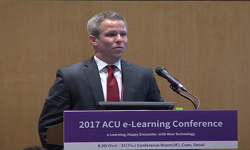In recent years, the rapid development of the internet and the sudden outbreak of the COVID-19 pandemic has made the blended teaching mode that combines online and offline the current primary teaching mode in China. With the normalization of the COVID...
http://chineseinput.net/에서 pinyin(병음)방식으로 중국어를 변환할 수 있습니다.
변환된 중국어를 복사하여 사용하시면 됩니다.
- 中文 을 입력하시려면 zhongwen을 입력하시고 space를누르시면됩니다.
- 北京 을 입력하시려면 beijing을 입력하시고 space를 누르시면 됩니다.
(A) study on optimizing blended teaching mode in universities in China during the post COVID-19 pandemic era
한글로보기https://www.riss.kr/link?id=T16395850
- 저자
-
발행사항
Seoul : Sungkyunkwan University, 2022
-
학위논문사항
Thesis (M.A.) -- Sungkyunkwan University , Department of Education , 2022. 8
-
발행연도
2022
-
작성언어
영어
- 주제어
-
발행국(도시)
서울
-
기타서명
포스트 코로나 시대에 중국대학의 혼합식 교육모델 최적화에 관한 연구
-
형태사항
ii, 86 p. : ill. ; 30 cm
-
일반주기명
Adviser: Jangwan Ko
Includes bibliographical references: p. 64-75 -
UCI식별코드
I804:11040-000000171230
- DOI식별코드
- 소장기관
-
0
상세조회 -
0
다운로드
부가정보
다국어 초록 (Multilingual Abstract)
In recent years, the rapid development of the internet and the sudden outbreak of the COVID-19 pandemic has made the blended teaching mode that combines online and offline the current primary teaching mode in China. With the normalization of the COVID-19 pandemic, how to optimize the blended teaching mode has become a hot topic in the field of education. Accordingly, the purpose of the current study was to identify the factors that influence the students' satisfaction with the blended teaching mode among students in two Chinese universities during post the COVID-19 pandemic era to optimize the blended teaching mode in Chinese universities.
Two hundred ninety nine students participated in the current study, and results were collected through the questionnaire survey. The significance was analyzed through descriptive statistics, independent sample t-test, one-way ANOVAs, and multiple regression. The result showed no significance between gender, major, grade, or type of school on students' satisfaction. The content of teaching, the interaction between students and teachers, and the integrity of the network platform have significant positive impacts on students' satisfaction with blended teaching mode during the post the COVID-19 pandemic era. In contrast, the learning autonomy of students and the studying environment of students were found to have no relationship with students' satisfaction. Therefore, to optimize the blended teaching mode, blended teaching should be improved in three aspects: The content of teaching, the interaction between students and teachers, and the integrity of the network platform.
국문 초록 (Abstract)
최근 몇 년 동안 인터넷의 급속한 발전과 코로나 19의 갑작스러운 발생으로 인해 온라인과 오프라인을 결합한 혼합식 교육모델이 현재 중국의 주요 교육 방식이 되었다. 코로나19가 정상화되...
최근 몇 년 동안 인터넷의 급속한 발전과 코로나 19의 갑작스러운 발생으로 인해 온라인과 오프라인을 결합한 혼합식 교육모델이 현재 중국의 주요 교육 방식이 되었다. 코로나19가 정상화되면서 혼합식 교육모델을 최적화하는 방법이 교육계에서 점차 화제가 됐다. 따라서 본 연구의 목적은 포스트 코로나 시대에 중국 두 가지 대학의 학생들을 대상으로 혼합식 교육모델에 대한 학생들의 만족도에 영향을 미치는 요인을 규명하여 중국 대학의 혼합식 교육모델을 최적화하는 것이다.
본 연구에는 총 299명 중국 대학생 참여하였으며 설문조사를 통해 결과를 수집하였다. 유의성은 기술통계, 독립표본 t검정, 일원분산분석, 다중회귀분석을 통해 분석하였다. 결론은 학생들의 수업만족도는 성별, 전공, 학년, 학교유형 간에 유의한 차이가 없는 것으로 나타났다. 수업 내용, 학생과 교사 간의 상호 작용, 네트워크 플랫폼의 무결성은 포스트 코로나 시대에 혼합식 교육모델에 대한 학생들의 수업만족도에 유의한 긍정적인 영향을 미치는 반면 학생의 학습 자율성과 학습 환경은 학생들의 수업만족도와 관련이 없는 것으로 나타났다. 따라서 혼합식 교육모델을 최적화하려면 혼합 교육은 수업 내용, 학생과 교사 간의 상호 작용, 네트워크 플랫폼의 무결성이라는 세 가지 측면에서 개선되어야 한다.
목차 (Table of Contents)
- Chapter 1. INTRODUCTION 1
- 1. Research Purposes and Necessities 1
- 2. The Significance of Research 3
- Chapter 2. THEORETICAL BACKGROUND AND LITERATURE REVIEW 7
- 1. The Concepts of the Teaching Mode 7
- Chapter 1. INTRODUCTION 1
- 1. Research Purposes and Necessities 1
- 2. The Significance of Research 3
- Chapter 2. THEORETICAL BACKGROUND AND LITERATURE REVIEW 7
- 1. The Concepts of the Teaching Mode 7
- A. Traditional Teaching Mode 7
- B. Online Teaching Mode 8
- C. Blended Teaching Mode 9
- 2. The Theoretical Background of the Blended Teaching Mode 12
- A. Constructivist Theory 12
- B. Humanistic Learning Theory 13
- C. Media Theory 15
- 3. Literature Review 17
- A. Previous Studies on the Blended Teaching Mode 17
- B. Studies on the Blended Teaching Mode in China 21
- Chapter 3. RESEARCH METHOD 25
- 1. Research Questions 25
- 2. Research Design 26
- 3. Participants and Data Collection 28
- 4. Reliability and Validity of the Questionnaire 30
- A. Reliability 30
- B. Validity 31
- 5. Analytical Methods 35
- Chapter 4. RESULTS OF THE STUDY 38
- 1. Descriptive Analysis 38
- A. The Profile of Students’ Demographics 38
- B. Current Situation of the Blended Teaching Mode 39
- 2. Results of Group Differences 46
- 3. Significant Predictors of Students' Satisfaction 49
- Chapter 5. DISCUSSION AND CONCLUSION 54
- 1. Discussion 54
- 2. Conclusion 59
- 3. Implications 60
- REFERENCES 64
- APPENDIX 76
- <APPENDIX 1> 76
- <APPENDIX 2> 82
분석정보
연관 공개강의(KOCW)
-

2017 ACU 이러닝 국제 콘퍼런스
한국교육학술정보원 션 코너(Sean Connor), 아베리노 메지아(Avelino A. Mejia Jr.), 멜린다 델라페나 반달라리아(Melinda dela Pena Bandalaria), 가또 하리 쁘리오잔또 -

글로벌 인재포럼 2007: 고등교육의 질 관리
글로벌 인재포럼 Barbara Ischinger,, Peck Cho, Director, Roger Benjamin -

2011 Asian and Africa Womens conference
숙명여자대학교 한영실 -

글로벌 인재포럼 2007: 평생학습을 위한 대학의 역할
글로벌 인재포럼 Hans G. Schuetze, Richard Yelland, Dae-Bong Kwon -

글로벌 인재포럼 2007: 다양성과 질을 위한 대학교육의 혁신
글로벌 인재포럼 Mark S. Wrighton, Jamil Salmi, Barry McGaw







